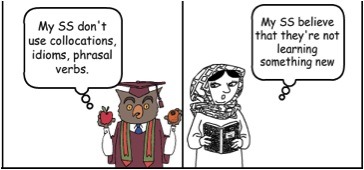Tweeting Through The Intermediate Plateau
Who are intermediate students?
Before we begin tweeting through ‘The Intermediate Plateau’ we must be aware that the intermediate level of language proficiency is a very broad category. One could visit an intermediate group of a language school and meet low intermediate, intermediate, high intermediate, upper-intermediate, etc. students. Let’s see what the CEFR has to say.
According to the Council of Europe (Threshold Level):
“Low intermediate level students can […] deal with most situations likely to arise whilst traveling in an area where English is spoken […and…] describe experiences, events, dreams, hopes, ambitions, and briefly give reasons and explanations for opinions and plans.”
“High intermediate level students can […] interact with a degree of fluency and spontaneity that makes regular interaction with native speakers quite possible without strain for either party […and…] produce clear text on a wide range of subjects and explain a viewpoint on a topical issue giving the advantages and disadvantages of various options.”
Is this, though, what our intermediate students really do? I often find myself in one of the following situations:


Created with makebeliefscomix.com
What is in a Tweet?
- 140 Characters: Dense/Succinct language is needed in order to produce a complete, coherent tweet.
Writing/Speaking: Tweeting seems to be a writing task; however, the very nature of each tweet has also an ‘oral’ element in it. This makes tweeting a multiple skills development task in which both introverts and extroverts can participate (which is something that does not happen in oral activities) - Public: Posting something that will be publically available makes the one who posts it more serious about it. This means that there are more possibilities for students to self-correct (or, even better peer-correct) before pressing the ‘send’ button.
- Authentic Communication: Twitter is a medium that students use on their everyday out-of-class lives. If used wisely, it can transform all student activities seem less as activities and more as a ‘natural’ thing to do.
- Interactive: In the early days of blogging, educators had commented on one of the great benefits of students’ blogs: the fact that they could post their comments to each other’s’ post. With Twitter, this has been maximized with the ‘reply’ and ‘retweet’ function of Twitter and it has transformed tweeting into a fun, collaborative, and communicative activity.
What to do with Twitter in (and out of) the classroom
Communicate with your students outside the class.
I often find that keeping in touch with my students outside the class helps them develop from group to team; this, in turn, makes group dynamics much easier for me to handle and use.
What is very important here is for the teacher to decide what kind of ideas/things they want to communicate through Twitter. I personally use the class’ hashtag to tweet about everything: an interesting movie I watched, an educational article I read, a note about their homework, a question that I want my students to think about before coming to class, etc.
At first, it takes a lot of effort from the teacher’s part mainly because teachers need to act as moderators and follow up all students’ contributions. Gradually, though, once they see that there is an interest in what they are saying, they become more and more involved, making our job easier.
Let them keep notes while in class.
This is particularly useful in contexts where lecturing is unavoidable (e.g. English for academic progress). Let your students use the classroom hashtag in order for them to post their reactions, questions, and comments to what is going on in the class/lecture theatre.
Backchannel discussions can some (if not most) of the time be much more interesting and fruitful than the lecture itself. It is extremely interesting to let your students share their ideas, provided, though, that you will follow their tweets up, holding a post-lecture discussion, for example.
Twitter Essay Challenges.
Students, especially teenagers, enjoy participating in online challenges. Why don’t you send them a tweet with a question and ask them to answer this question in 6 (or less/more) tweets?
Also important here is that teachers follow this activity up. If, for example, each of their tweets is one of the each student’s main points, they could then use the tweet as the topic sentence of a paragraph that they, then, would expand. So, from a twitter essay, they can create a whole ‘ordinary’ essay.
Connect with learners/classes from around the world.
What’s the best thing Twitter has done for us, teachers? We followed other teachers whom we admire and we keep on learning from each other. Why don’t we do this for our students, too? Find colleagues that use Twitter with their classes and ask your students to follow your colleagues’ students. Set up collaborative projects and let them communicate for anything that satisfies their appetite.
Have you tried using Twitter with your students? Share your experience in the comments area below the post.




